Barbie Bertisch & Paul Raffaele
Interview by Ben Goldfarb aka DJ Scribe | Photos by Eilon Paz
had hoped that we’d be schmoozing over Vietnamese food and beer in Greenpoint but I am laid up in bed with the Flu and a fever, sweating my ass off, when I Facetime video call Barbie and Paul to begin. Over the past year or so we have gotten to know each other pretty well, working on a few projects together related to Love Injection, the fanzine about the NYC underground dance scene that they have produced together (for the most part) since 2015, and become friends.
Barbie and Paul are highly ambitious and successful people but extremely humble to the point of self-deprecating, despite being the pre-eminent documentarians and torch-bearers of the scene. Their current projects include producing the well-curated and beautifully designed (by Paul) zine on a roughly monthly basis for the past four years; hosting monthly sessions of the NYC arm of Classic Album Sundays, an international series of hi-fi vinyl listening events; holding down a weekly radio show at The Lot every Saturday morning from 10-12 (Friday night gig or no); throwing their own party series, Universal Love; Paul running a record label, Most Excellent Unlimited, and becoming the primary vinyl outlet for Danny Krivit’s legendary edits; Barbie playing bass and singing in a band called Seedy Films, put together by Luke Jenner of The Rapture with whom she co-manages forthcoming label Manono Records that will release the band’s first project; and both DJing constantly in NYC and around the world. All done with reverence, care, and humility. And while working full-time jobs.
I am in awe, always, and a bit delirious (from the fever) when I call. They are super sweet and perfect-coupley, as usual. We use a crazy hybrid spoken/written process I came up with where I ask them questions out loud and they both answer in writing, simultaneously, not seeing one another’s answers. And I watch them write in silence with occasional pauses to tease each other lovingly. We have a nice chat, the quiet punctuated by jokes and laughter, for a few hours as they graciously stave off pizza-hunger and answer my questions. Eilon would go over to their place to shoot the photos a couple days later.
After a few attempts to sync all our space-age technology, microphones, cameras and screens, we begin…
Where did you both grow up and what was the music of your childhood?
Barbie: I grew up in Buenos Aires, Argentina. I think the music that you listen to as a kid all comes from your parents, which also comes tied with what kind of upbringing you had: your neighborhood, if you went to any social clubs, politics, etc. South American societies are very stratified and music is a big part of that. I grew up mostly listening to my dad imitating Sandro, Michael Jackson, and Blondie. I do remember holding the A-ha CD a lot in my hands, the one with “Take On Me.” My mom was more into Electric Light Orchestra and Giorgio Moroder. When I started buying CDs, it was mostly ‘90s US and Latin pop. I lived a comfortable childhood and had traveled to the United States a bunch, like we used to go to Disney and whatnot, so I had more access to global music. Rock was really big in Argentina, so at an early age I was also starting to hear lots of Rolling Stones and britpop. I’m a bizarre hodgepodge of sounds.
Paul: Staten Island, New York. My parents played pop music in the house but didn’t have a point of view outside of that from what I can remember. Michael Jackson, Neil Diamond, Frank Sinatra. I always associate the song “Band Of Gold” by Freda Payne with my mother. The Batman Forever soundtrack with “Kiss From A Rose” was the first CD I ever bought with my own money. I met some friends that liked NY hardcore and screamo so I started listening to that eventually. Glassjaw, Sick of it All, The Postal Service, Radiohead, etc. Not sure how far I should go, or what constitutes the end of “childhood.” I still feel like a child.

Was there vinyl in your childhoods?
Paul: No. When my grandparents sold their home and we were cleaning it out, I inherited my uncle’s records which were up in the attic. Zeppelin, The Doors, The Cars, comedy albums like George Carlin, Andrew Dice Clay, etc., as well as his turntable. I was about 14. I remember loving the object, but didn’t really use it at first. It collected dust for a while until I started trying to scratch on it.
Barbie: Not really. I do remember lots of cassettes and CDs. We did have one of those stereo racks, like back then when you used to have one piece which was the tape deck, one was an equalizer, then the CD player, tuner, and so on. I was born in ‘88 so that was a bit past the vinyl era, I suppose. At least at home.
Do you still have any of those records, CDs or cassettes?
Paul: Yeah, I’ve got George Carlin’s Toledo Window Box and Andrew Dice Clay’s Dice somewhere in the kitchen. I also have the very first cassette tape I ever owned, Tag Team “Whoomp! (There It Is).” It looks like Dice is produced by Rick Rubin. Wonder how that happened. Listening back to it now I realize just how egregious Dice’s act was. As a kid, all I heard were the curse words, but listening now with adult ears and context, it’s extremely sexist, racist and homophobic. Fuck this guy.
Barbie: No, we shed a lot of belongings when we moved from Buenos Aires to Miami. And then I shed some more when I moved to New York. I was just visiting my folks down there and I was digging through stuff and found a record that I think my dad was either in or somehow part of. One of those school choir records.
 Andrew Dice Clay’s Dice and George Carlin’s Toledo Window Box. I found these in my grandparents attic when they were moving out. They were, in with some combination, my father’s and uncle’s. It was the first time I had touched the format. It was also a masterclass in profanity. I in no way endorse the views of Andrew Dice Clay.
Andrew Dice Clay’s Dice and George Carlin’s Toledo Window Box. I found these in my grandparents attic when they were moving out. They were, in with some combination, my father’s and uncle’s. It was the first time I had touched the format. It was also a masterclass in profanity. I in no way endorse the views of Andrew Dice Clay.  Produced by Rick Rubin. Wonder how that happened…
Produced by Rick Rubin. Wonder how that happened…
When and how did you get deeper into music and collecting records?
Paul: My father’s friend, we’ll call him Johnny C, was a mobile DJ. He actually invited my dad to help him DJ some holiday and New Years parties when they were younger. He knew I loved music and would invite me to help him DJ weddings, birthday parties, bat mitzvahs, etc. He told me he had records at home that he was getting rid of and offered them to me, so I took on a few hundred.
I liked the way they looked on my shelf all stacked up next to one another, and I think that’s when I felt like I started to form a collection. Around that time I caught a show on BET called Rap City: Tha Basement with Big Tigger hosting. The intro sequence had guest DJs cutting and scratching the Rap City theme song and they always had really dope looking modified Technics 1200s. I got a job as a busboy at a country club around that time, and the first thing I did with that money was buy a pair of Gemini PT2100s and a 2-channel Vestax VMC 002XLu. Technics were too expensive, and I had no context to know they were industry standard. The Geminis served me well for those early years. I would go to Our Music on Hylan Blvd. and ask for records I could learn to scratch with. They had no idea what I was asking for, so I just bought shit I found on the wall and made the best of it. I didn’t even have proper headphones so I’d hold the ⅛” jack (wrong size for a DJ mixer) with one hand and scratch with the other. It was not efficient. I then started to learn a little about hip-hop and bought mainstream things like “Juicy,” “Superthug,” “Real Love,” Eve‘s “Let Me Blow Ya Mind,” The Beatnuts’ “Watch Out Now,” and things like that, that felt good to scratch to. I probably heard all of those on Tha Basement.
I tried planning the night in granular detail, but when I got there none of the records worked, nobody cared, and people requested hip-hop all night long. I learned that night the hard way that DJing is a give and take. You need to adapt on the fly.
Barbie: This is a two part answer for me because coming of age in the era of Limewire, Kazaa and all that, I got deeper into music when I started going out in Miami. Must have been when I was about 19. I had this boyfriend who was way older than me and who was into Depeche Mode, The Cure, and then all the indie bands of the time like The Strokes, The Rapture, etc. It’s funny using the word ‘indie’ now. Anyway, he exposed me to lot of music. And then there’s what I’d hear out, which was partly that, but then lots of DFA and Motown, soul and early rock ’n’ roll. From 2007 until I left Miami, I was basically going out Wednesday through Sunday, which my parents weren’t too keen on. But I met tons of people in nightlife. Once the floodgates were opened, it was about getting familiar with more and more stuff that I’d hear at the local spots like Revolver, Pawn Shop, Poplife, or Vagabond.
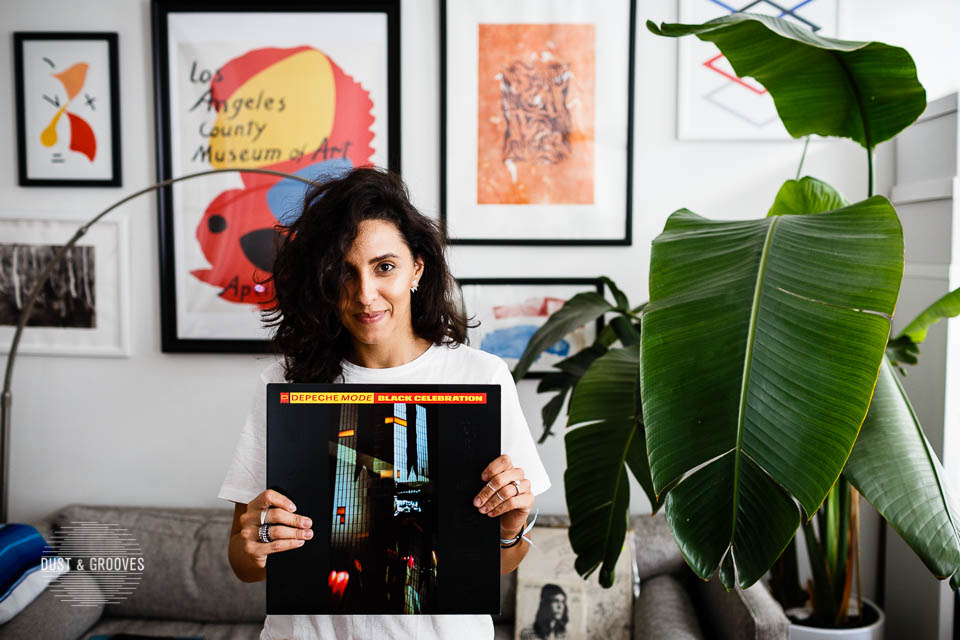 Depeche Mode, Black Celebration. A sound that’s been with me pretty much since the beginning.
Depeche Mode, Black Celebration. A sound that’s been with me pretty much since the beginning.
I moved to New York in 2011. I was still mostly seeing lots of live bands until my friend Maru, also a Miami transplant, brought me to this party (that I’ll leave unnamed). That was the beginning of my collecting records. I became part of a crew where mostly everyone DJed and so I asked if I could try it too. They, of course, said yes and taught me how to beatmatch. I owe tons to Francis, Shane, August, Farley and Eric, and the whole Loft crew, because they really gave me encouragement and space to grow. Shortly after, I started buying all sorts of records: 12-inch singles, but also tons of LPs that contained the album version of whatever extended version I couldn’t afford or find.
Do you still have any of those first records you bought or inherited?
Paul: Yeah. Connie Francis – Love Italian Style, Jimmy Roselli – New York, My Port Of Call, Lou Monte – Shaddap You Face. My father’s friend John is Italian-American, and living in Staten Island, he had a lot of clients who were as well, so he had a lot of those records. I also found “Juicy” and Black Rob – Life Story with “Whoa!” on it, which are probably the last two hip-hop records from that time that I still own.
Barbie: Yes, I remember some early ones were this 12-inch by Paradise’s Deep Groove, I think, called “I Love,” and this Joey Negro Italo house compilation. But it’s all real messy because I bought a lot of records in the beginning.
 Italo House Part One Compiled by Joey Negro was the beginning of my searching for ‘dance’ music.
Italo House Part One Compiled by Joey Negro was the beginning of my searching for ‘dance’ music.
 Connie Francis, Love Italian Style; Jimmy Roselli’s New York, My Port of Call, and Lou Monte’s Shaddap You Face. I was given these from my father’s old friend and ex DJ partner. The first time I had enough records on my shelf for someone to consider it a “collection.”
Connie Francis, Love Italian Style; Jimmy Roselli’s New York, My Port of Call, and Lou Monte’s Shaddap You Face. I was given these from my father’s old friend and ex DJ partner. The first time I had enough records on my shelf for someone to consider it a “collection.”
What were some of your first proper DJ gigs and what did you play?
Paul: My very first gig was at a bar called Visions on Hylan Blvd on Staten Island. I was about 15. I planned every record I would play and scribbled them out by hand. I even brought my turntables with me (with no road cases) so that I could mimic my home setup as close as possible. When I got there and saw a 4-channel Rane MP24 and I thought my head was going to explode. I had never seen anything but a 2-channel battle-style mixer. I played tracks like Industry – “Release Me,” Amuka – “Appreciate Me,” and DERB – “DERB.” I had a lot of Star69 records. The only record store I knew in the city was Deca Dance and they had a lot of this circuit tribal and vocal stuff. I tried planning the night in granular detail, but when I got there none of the records worked, nobody cared, and people requested hip-hop all night long. I learned that night the hard way that DJing is a give and take. You need to adapt on the fly.
Barbie: Well, beyond playing in my friends’ basements, I started DJing in 2014, almost 2015. Very early on, I was playing weeknights at Kinfolk 90, which a bunch of my friends were also doing. It was really fun because it was a low stress environment where I could mess up and not care. Especially when playing disco. Starting out trying to beatmatch with humans on the drums was a big learning lesson. All our friends would just come out to support each other and dance a lot. It was really fun and loose. I was playing lots of Salsoul records, tracks like “212 N 12th Street” and “Doctor Love.” The Philly Sound, if you will.
I remember early on in February 2015, I requested a date at Battery Harris to do something there. This guy Sigu who handled bookings there let me reserve a night and put some DJs together. I had recently met Paul at Academy in Greenpoint and he told me he was starting this zine, so I invited him to turn the night into a release party and we invited our friends Thomas Hall and Ryan Kunimura to play with us. I’m pretty sure that was the first time we played together.
Do you have any of those records?
Paul: Yeah, I recently put aside DERB & “Sandstorm” for LOLs.
[Paul makes fun of Barbie for over-organizing]
Barbie: I keep my records very organized and I barely get rid of any, so yeah. Haha, I’ve kept the “Doctor Love”s, the “Ten Percent”s, all that.
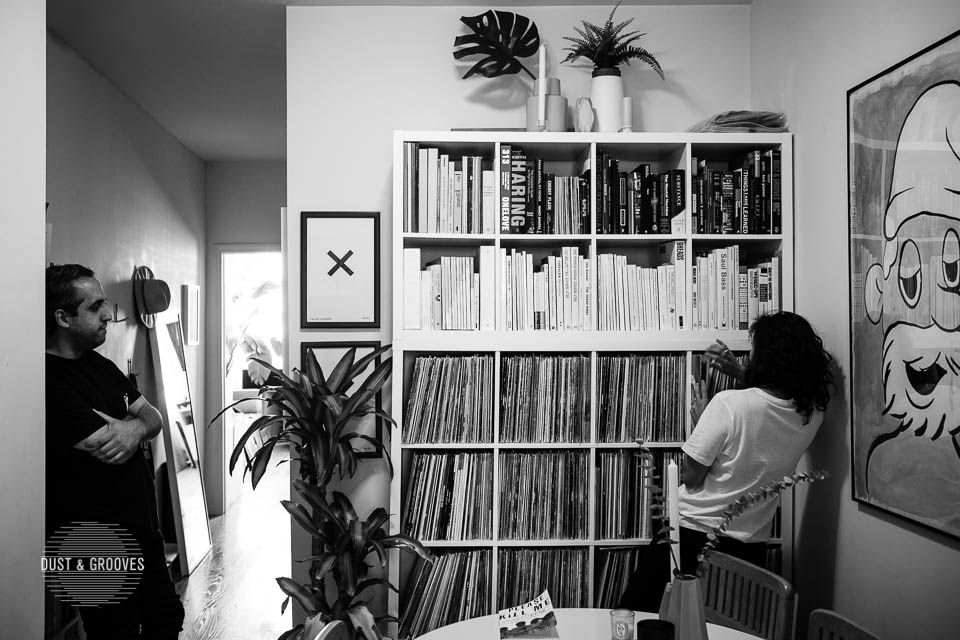
Is there a record that has played a significant role in your relationship?
Barbie: Definitely Songs In The Key Of Life by Stevie Wonder. Paul and I had been friendly for a few months, were DJing together, and going on dates and stuff, but I was in this “I don’t want a relationship” headspace. Stevie Wonder announced he’d tour the album and Paul invited me to go with him. Little did I know that, in his mind, he held the show as this “all or nothing” moment. Basically, if Stevie didn’t seal the deal, who could? It’s the message in the music, the fact that it was so personal to our coming together. Needless to say, the show was stunning and we’ve been inseparable ever since. The album has played a big role in our lives and the music has carried into our dance experiences, both at friends’ parties and ours. We’ve already agreed on “As” being our wedding song.
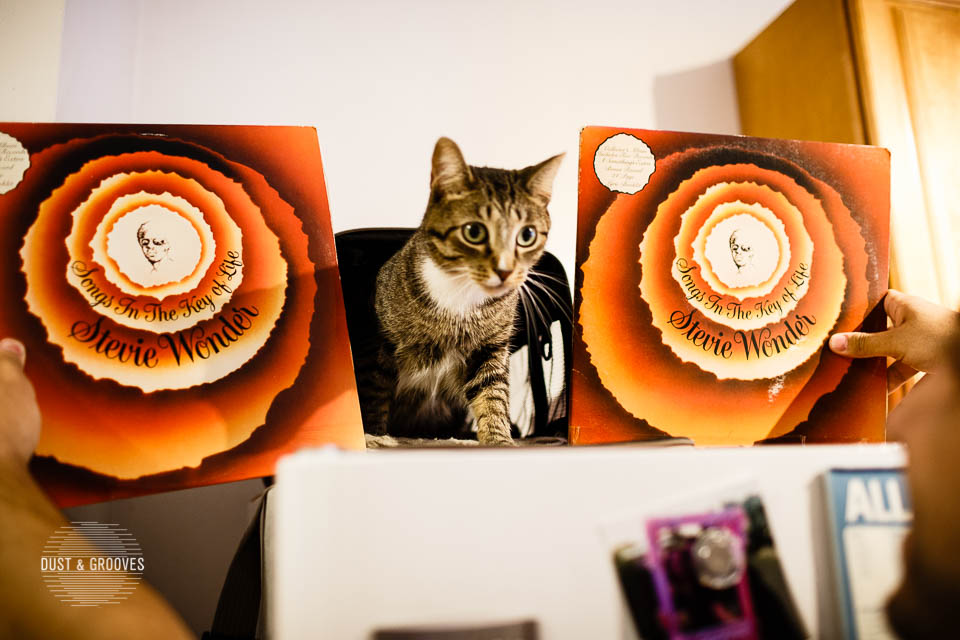 Stevie Wonder, Songs in the Key of Life. This album means so much to us, it basically marked the beginning of our relationship.
Stevie Wonder, Songs in the Key of Life. This album means so much to us, it basically marked the beginning of our relationship.
Do you guys share any records?
Paul: I mean, always and never. Our stuff is not stored together, but we’re constantly lending each other things. We recently went to Argentina and bought a lot of nice things. We couldn’t remember who paid for what, and for the first time we set aside a cube that we called “ours” even though it lives within a structure that is considered “mine.”
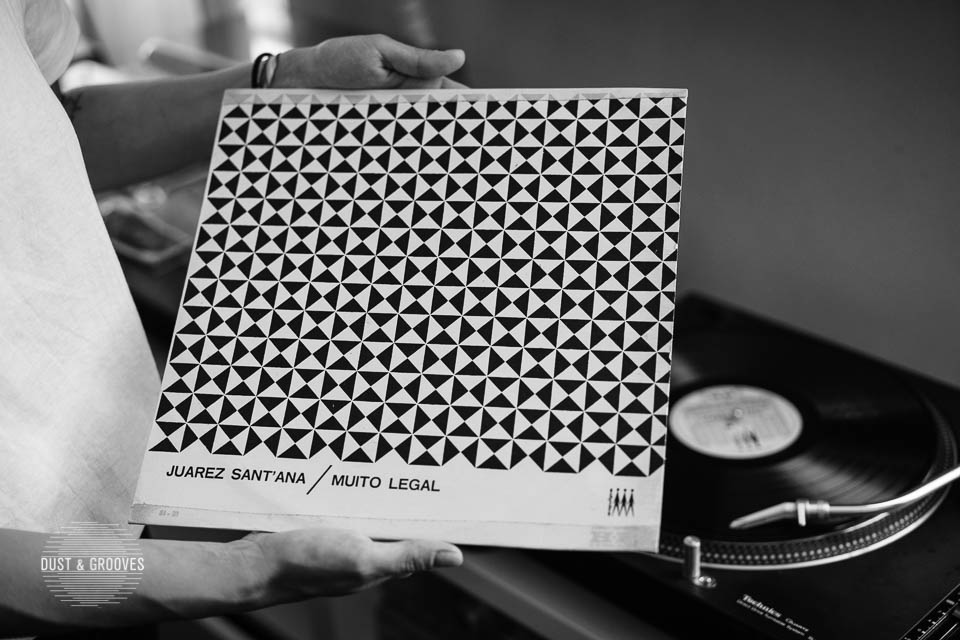 Juarez Sant’ana, Muito Legal. Bought from a dealer in Argentina who wanted to sell us ‘more interesting’ records such as The Police or AC/DC. Beautiful pre-bossa nova LP with spectacular artwork.
Juarez Sant’ana, Muito Legal. Bought from a dealer in Argentina who wanted to sell us ‘more interesting’ records such as The Police or AC/DC. Beautiful pre-bossa nova LP with spectacular artwork.
Also, records that we buy specifically for Classic Album Sundays are treated as “ours” as well, as the event pays for the records that we buy for those sessions.
Barbie: We started traveling more together, and with traveling came record purchases. He makes fun of me for being too organized with them; well, the truth is his record collection has no logic. So I can’t trust him to store any of the records we buy together because most likely, I will never see them again.
Paul: Tell Ben about the Pato C records.
Barbie: When I started traveling to Argentina on my own, I’d go record shopping and roam and reacquaint myself with the city. In one of these early trips of my own, I came across this guy, Pato C, who I was told was a big DJ back in the day. It was the artwork that did it for me: Pirate Disco Volumen 3. Pato C turned out to be a major bootlegger but made it possible for all this music to enter the Argentinian market via his compilations. He’d change the names of the artists and the songs to kill the paper trail, so to speak, and he’d have the marketplace to himself, basically. Some include megamixes that are just so terribly done but effective for people who wanted a record to play at a party, or something like that. The sound quality is terrible, the artwork even worse, which makes it all that much funnier. So now every time we go back to Buenos Aires, we hunt down Pato C records.
 Our lot of Pato C Records, the famous Argentine DJ known for bootlegging US and European disco tracks and introducing them to the local crowds.
Our lot of Pato C Records, the famous Argentine DJ known for bootlegging US and European disco tracks and introducing them to the local crowds.
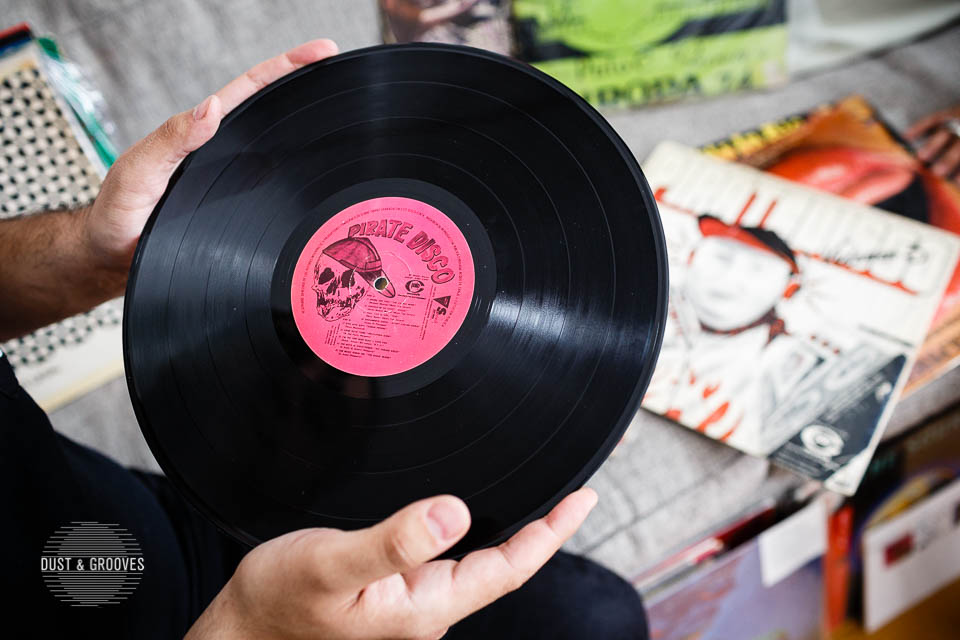 Pato C, Pirate Disco Vol 3. The first we got our hands on and the one that took us down the rabbit hole.
Pato C, Pirate Disco Vol 3. The first we got our hands on and the one that took us down the rabbit hole.
Paul: I was drawn to this War 7-inch because of the interesting looking receipt that was used as the paper jacket. It’s got all of this schizophrenic typography on it, like ten different typefaces. I can’t read it, but Barbie says it’s got no relationship to the music and looks like a tile materials order. I brought it to the counter and immediately, Charley, the clerk took the jacket off and was replacing it with a new one. I stopped him and told him I had the record already, what I was interested in was the jacket! He gave me a very Argentinean look, probably thought I was a “boludo,” put the jacket back on and gave it to me. It’s got an awesome looking insert for the store inside too.
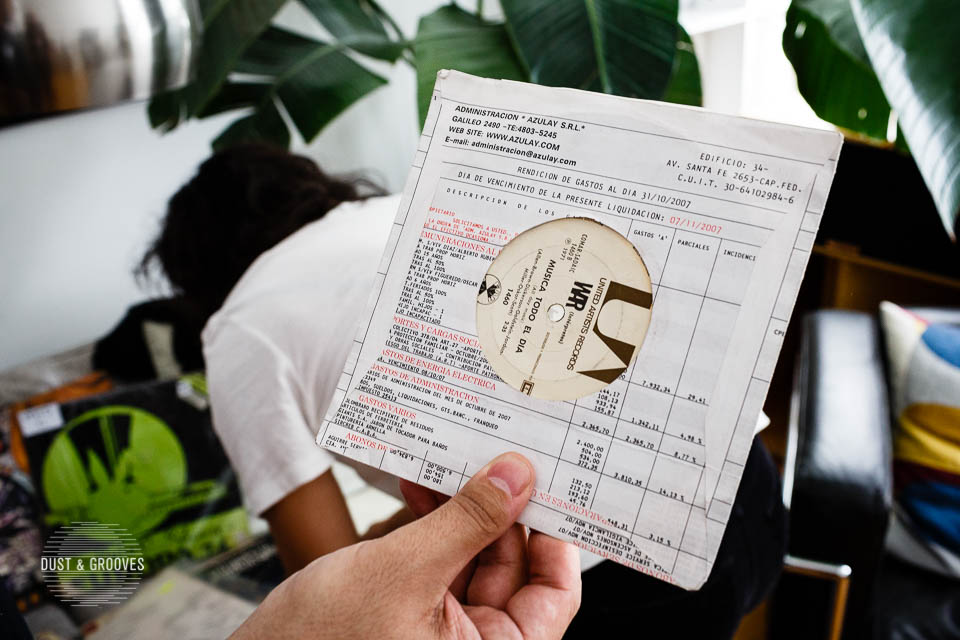 Gorgeous 7-inch sleeve that the shop owner almost threw out while digging in Argentina! It’s made from a plumbing receipt.
Gorgeous 7-inch sleeve that the shop owner almost threw out while digging in Argentina! It’s made from a plumbing receipt.
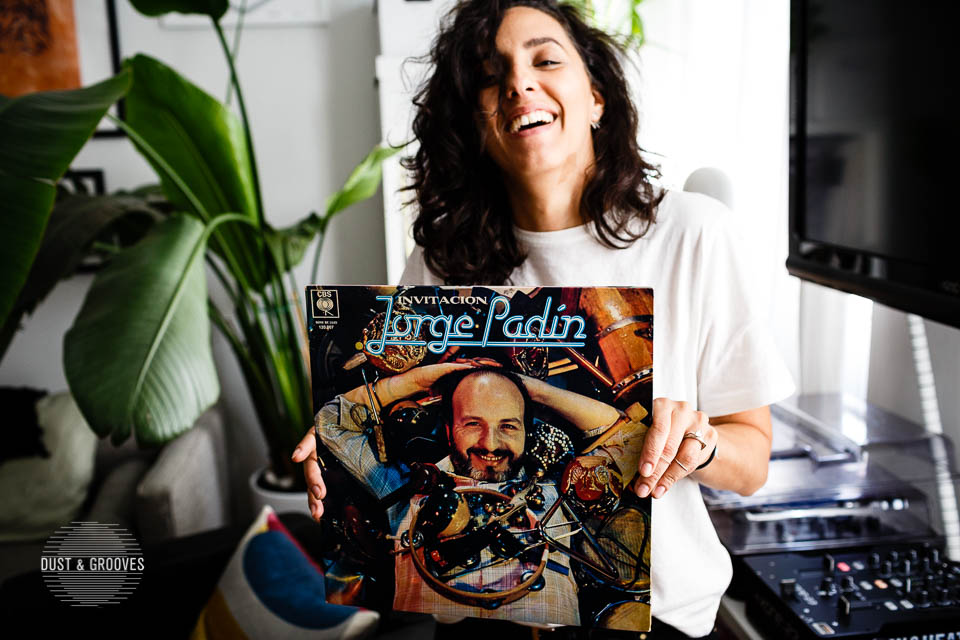 Jorge Padin, Invitacion. Another gem from our trip to Buenos Aires. Percussion perfection.
Jorge Padin, Invitacion. Another gem from our trip to Buenos Aires. Percussion perfection.
Which came first, hosting Classic Album Sundays in NYC, your record label Most Excellent Unlimited, or publishing the Love Injection fanzine?
Paul: Most Excellent was born in the ashes of a party I threw for three years called The Dog & Pony Show. I had a partner, in the end we had some major differences of opinion as to the direction the party should go in and I needed to do something on my own. I started the label with Ma Spaventi’s Revolver EP in September 2013.
Love Injection started in February 2015, and CAS started because we interviewed Colleen (DJ Cosmo) for issue #5 in June 2015. We became friendly, and she became a mentor to us.
 Trussell, “Love Injection.” The namesake of our fanzine born out of a frenzied experience while listening to it at The Loft.
Trussell, “Love Injection.” The namesake of our fanzine born out of a frenzied experience while listening to it at The Loft.
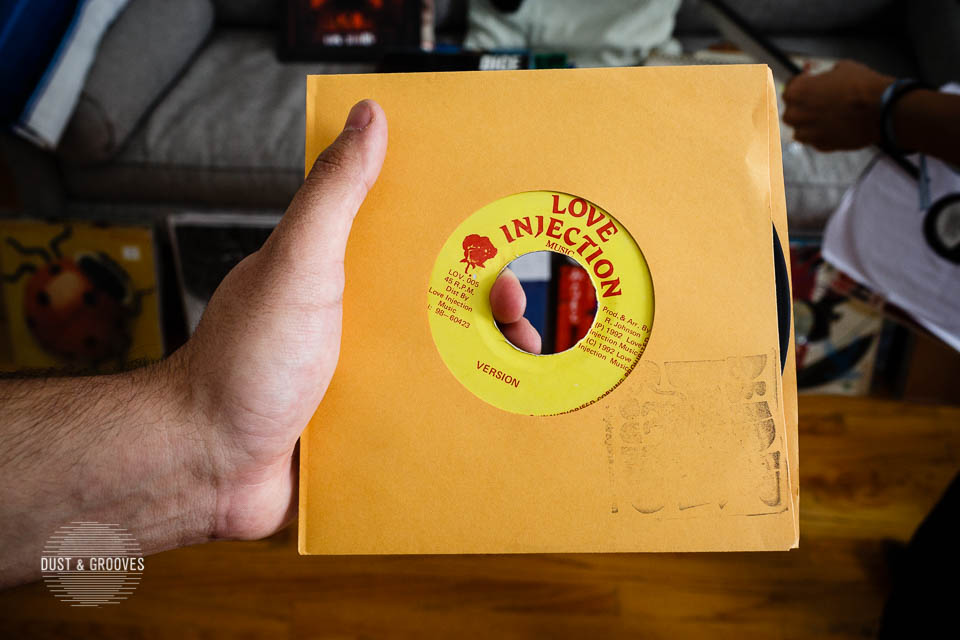 Later on, we found out there’s a reggae label called Love Injection. Found a few of them via Deadly Dragon Sound System.
Later on, we found out there’s a reggae label called Love Injection. Found a few of them via Deadly Dragon Sound System.
Danny has chronicled every record he plays at his parties with time stamps. I felt really honored to be added to the list, and it was (and still is) a tremendous music discovery tool for me.
What do you look for in terms of music to release on the label?
Paul: Anything that sounds interesting to me. There was never a focus on genre. The label has never had a regular release schedule, I’ll only put things out if I happen to find something that moves me.
 Jesus Loves You – “Generations Of Love,” Toribio – “Esa Montana Se Movera,” Phil Moffa – Rareforms, and Ma Spaventi – “Revolver.” Selected grip of Most Excellent Unlimited recordings over the last five years.
Jesus Loves You – “Generations Of Love,” Toribio – “Esa Montana Se Movera,” Phil Moffa – Rareforms, and Ma Spaventi – “Revolver.” Selected grip of Most Excellent Unlimited recordings over the last five years.
How did you connect with Danny Krivit and start releasing his edits?
Paul: I’ve had very formative experiences with music at Danny & Benny (Soto’s) party 718 Sessions. It’s what really course corrected my path at the time, the same path I’m on today. At that time I didn’t know Danny that well personally, but knew him enough for him to recognize me and say hello. We got a bit more friendly from my going to the party so often and eventually he added me to his coveted email list to which he sent out his playlists after every party. For the better part of his career, Danny has chronicled every record he plays at his parties with time stamps. I felt really honored to be added to the list, and it was (and still is) a tremendous music discovery tool for me.
In studying his playlists, I noticed a lot of the songs had “Edit by Mr. K” next to it. I was aware of the more popular ones he had done like “Love Is The Message” or “Feelin James,” but there were a lot I couldn’t find online. So I asked him if he’d like to get pizza one night, and I planned to ask him if he would be interested in releasing some of these edits on my new label. We went on to have many meetings at Kesté, his favorite place in the West Village. He said my idea came at a good time, as he was a little fed up with waiting so long for promos from labels he was working with in Japan and Europe, and that he was interested in trying it out. From there we naturally got closer via our partnership, and eventually became very close friends.
We’ve released something like 20 records together over the last five years, and “Edits By Mr. K” runs parallel to original productions that I sign as I’m inspired.
 Two limited edition 7-inch box sets we produced filled with re-edits by the legendary Mr. K.
Two limited edition 7-inch box sets we produced filled with re-edits by the legendary Mr. K.
For Classic Album Sundays, do you get to pick the featured albums or related material?
Barbie: It’s actually a process we go through with all the other cities that partake in the program. Each time we do a session, there’s a list where people can suggest albums they wish to listen to in future sessions. We take all those suggestions, plus our own, and at the end of the year, we come together with the other hosts and we handpick the albums for the entirety of the coming year. Sometimes we do special sessions that maybe feel special to New York or based on a specific anniversary, but we try to approach these albums on a global scale and see how each market reacts differently because music is also pretty regional, at times.
When it comes to the sessions themselves and what we call the “music lead-up,” we try to give context to our album of the month. So we’ll choose music that the artist released prior, or music by album collaborators, or even sounds of the era. We think it’s important to give that context in order to get ourselves into the headspace or wavelength of this thing we’re about to throw ourselves into.
Then, we listen to the album from beginning to end. It can be pretty powerful considering most people only listen to singles or can’t even sit still for a whole song. We like to say that we try to absorb the music ‘like the artist intended’ which I suppose also is the philosophy of the Loft parties, which are also a big inspiration.
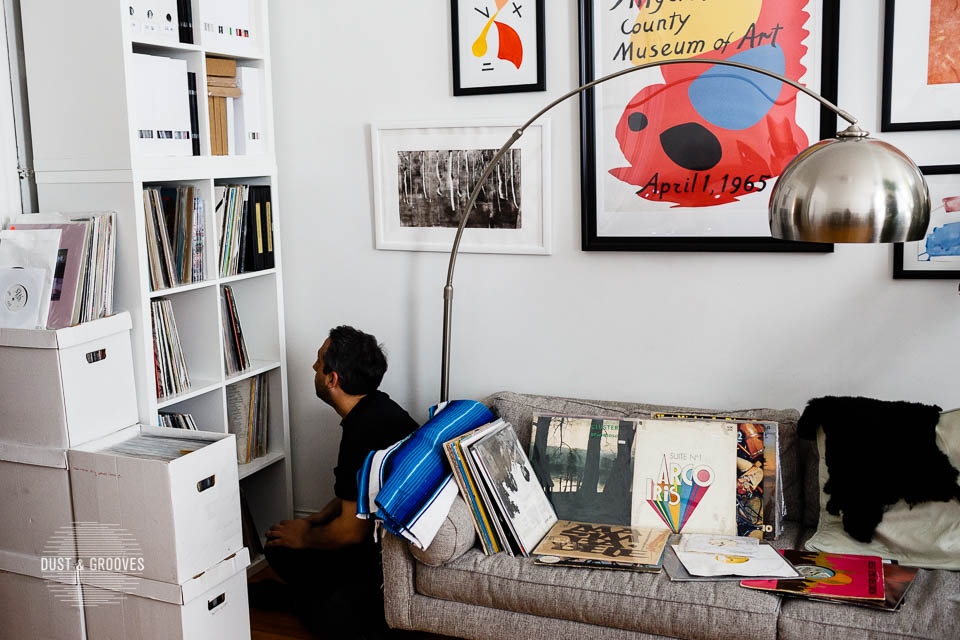 It’s OK Paul, you can come out now…
It’s OK Paul, you can come out now…
Any favorites?
Barbie: So many. I personally really enjoyed Patti Smith’s Horses and she became a big influence on my life afterward. I had previously read Just Kids but now I’m kind of Patti-obsessed. Lenny Kaye was a guest presenter for that session, which was amazing. We had a really great Fela Kuti session with Michael Veal, who’s a professor of ethnomusicology at Yale and who totally blew us away with his insight. For Daft Punk’s Discovery we screened Interstella 5555 simultaneously, which was a big production but turned out awesome. There are so many memories. I think one of our best sounding albums was Steely Dan’s Aja. Our friend Takaya Nagase loaned us a Mobile Fidelity Sound Labs pressing and it was out of this world. We also played some clips from the making of documentary and they’re just hilarious characters.
Oh! And J Dilla’s Donuts presented by Chairman Mao. He’s got an open invite to come present literally anything he wants ever. He came through with all the samples used in the album. It was phenomenal.
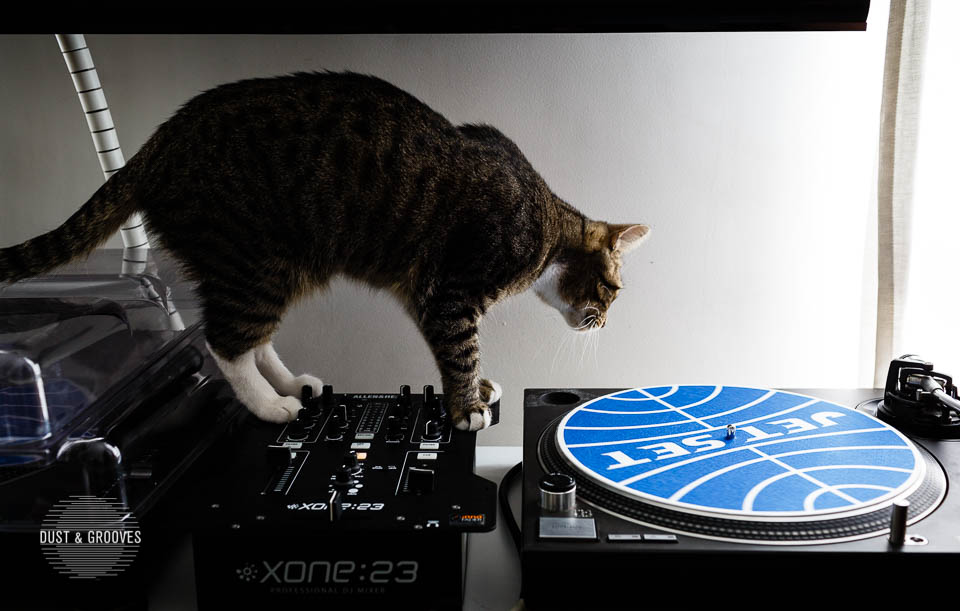 Stevie, named after Stevie Wonder. Rescued from from Oak St in Greenpoint while I was wearing a Stevie Wonder t-shirt.
Stevie, named after Stevie Wonder. Rescued from from Oak St in Greenpoint while I was wearing a Stevie Wonder t-shirt.
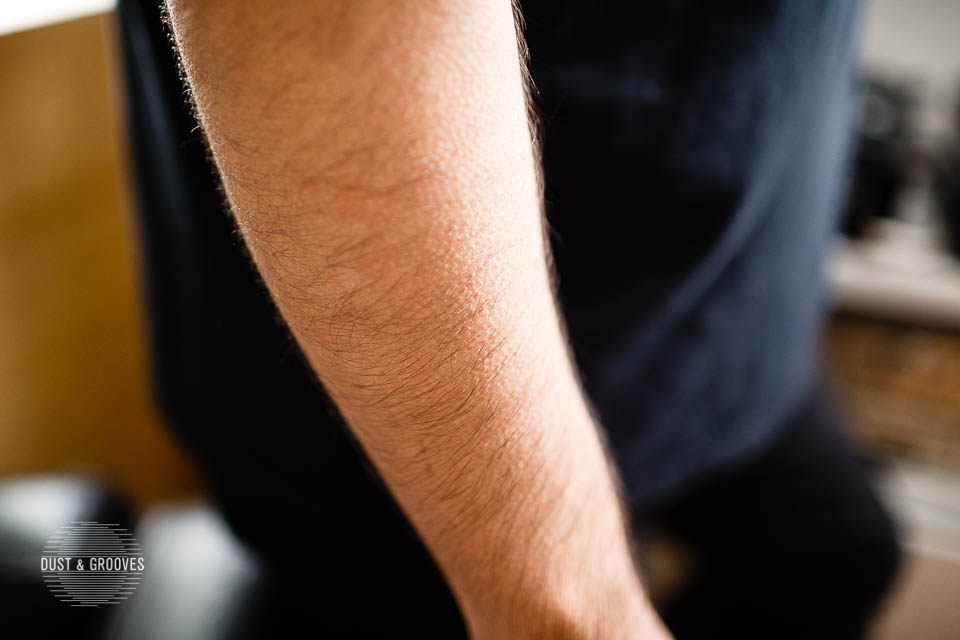 Goosebumps
Goosebumps
Anything you want to show?
Barbie: We have all the albums we’ve featured. I remember seeking out an original pressing of My Bloody Valentine’s Loveless for our session. This was prior to the reissue that came out this year… so it was an expensive and arduous search for the right copy to play, especially since our equipment is pretty sensitive to scratches or even dust. We made the money back because the album was so hard to come by, that people really came out in numbers for that one. There had been rumors of the upcoming reissue which ended up coming out a year after we featured it. I’m a big MBV fan. I was in Denver for Rocky Mountain Audio Fest last year hosting a weekend’s worth of sessions and almost added it on the program, but the album isn’t exactly made for hi-fi listening. I did throw it on in between sessions just out of curiosity. Hearing multiple layers of tremolo guitars played on a $20,000 turntable was enlightening, but “real audiophiles”—you know, the stereotypical middle-aged basement audio nerd—aren’t too keen on shoegaze. I got a kick out of introducing something non-traditional to an audience that isn’t used to hearing non-audiophile classics.
Universal Love was born and it’s been our small way of contributing to our scene with a thoughtful party that puts forth all the principles we want to see in the world: togetherness, inclusivity, freedom of expression, as well as a place to learn and discover music new and old as the artist intended it on a beautifully clear Klipsch sound system.
 A collection of My Bloody Valentine records. One of my favorite Classic Album Sundays sessions was Loveless, which we did a few years back. I became a fan when seeing them live in NYC in 2008.
A collection of My Bloody Valentine records. One of my favorite Classic Album Sundays sessions was Loveless, which we did a few years back. I became a fan when seeing them live in NYC in 2008.
How did Love Injection get started?
Paul: I conceived and produced Love Injection #1 solo, right around the time Barbie and I first met at Academy Records on Oak Street in Greenpoint. I was living in Hell’s Kitchen at the time, so it really was a trip for me to get out there. I was trying to figure out how I could gracefully contact her with purpose, so I came up with the idea to ask her to contribute to the zine. I knew she was part of the Loft community, and I asked if she could spearhead a column and ask those folks to contribute. She accepted, and she let me know that she had booked a venue for a party she wanted to throw. It would be her first time playing outside of friend’s houses. She asked me if I had plans to do a release event for the zine and I didn’t, so she offered to make that night the Issue 1 release party. I accepted, and that was the first of many many DJ sets together. Ryan Kunimura and Thomas Hall also played. Thomas lent us his Rane rotary mixer and both struck me as very nice, but skeptical of me. They were super protective over Barbie. I didn’t get it at first, but as I got to know them I found it really endearing.
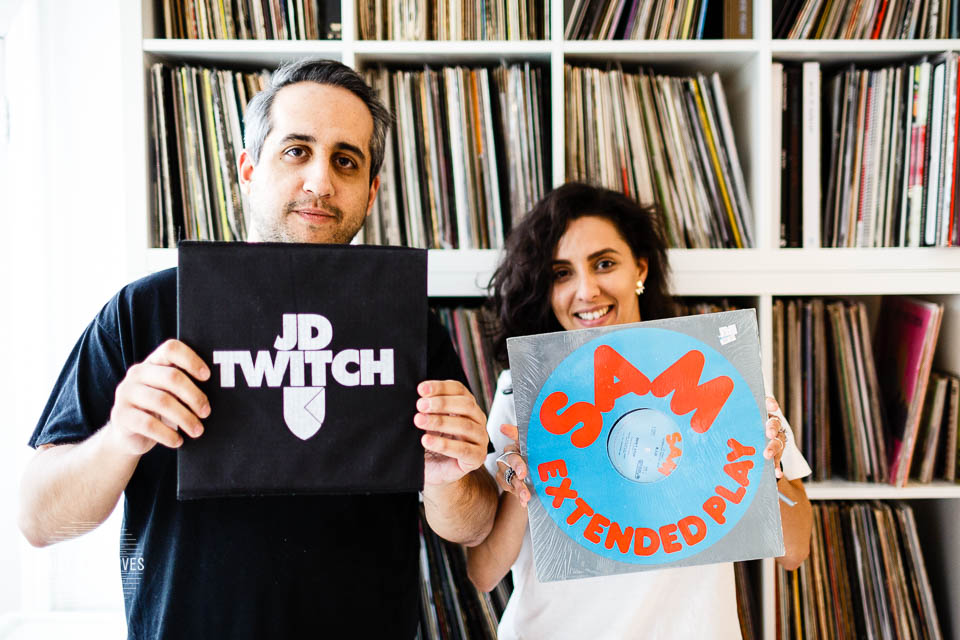 K.I.D., “It’s Hot” and JD Twitch, “10 Inches of Fear.” These are the records we bought at Academy on Oak St the day we met.
K.I.D., “It’s Hot” and JD Twitch, “10 Inches of Fear.” These are the records we bought at Academy on Oak St the day we met.
So, between us, Love Injection was basically just a way to meet Barbie, but now it’s too late to stop the charade even though the name is a dead giveaway?
Paul: Forty-two issues later, I’m still trying to cover up that very basic truth.
We also are thinking about and pushing David [Mancuso’s] idea of the three phases of a night: Calm, Circus and Re-entry. Calm is when folks are just arriving, getting settled and finding their place on the floor; Circus is where the full-on party moments and hardest dancing occurs, and finally, Re-entry is where we “land the plane.” A plane can’t just drop out of the sky, it needs to land gracefully so people can walk out into the normal world again in one piece.
What is a record that you bought because somebody mentioned it in Love Injection?
Barbie: Kris Petersen used to have this awesome column in which he’d review old and new music that he was into. He has a really great writing style and fantastic taste in music. I remember bonding with him over this blurb he wrote on Propaganda. I’d always liked them but never connected over them with anyone before. After that, I started keeping an eye out for Propaganda records, specifically A Secret Wish. Then, I realized it was released on ZZT, which is Trevor Horn. Then, it all made sense because I love his sound.
We love to read people’s contribution through the charts, too, which are kind of quick picks of records that people have on rotation at the moment. It’s a time capsule but also puts other people onto new music.
 Propaganda, A Secret Wish. A personal favorite that ties in with my early years of discovering music on my own and finding new friends who dig this stuff along the way.
Propaganda, A Secret Wish. A personal favorite that ties in with my early years of discovering music on my own and finding new friends who dig this stuff along the way.
When did you start your Universal Love parties and what is your approach with them musically and otherwise?
Paul: I was asked to speak on a panel about zines at Brooklyn Electronic Music Festival in 2016, and Stephanie Orentas from La Liga mentioned how she threw regular fundraising parties to support her operation. When she said that, I thought: how stupid are we that we haven’t thought of throwing a party to help with costs? It’s something we know how to do very well.
Also around this time, Barbie and I were going to this very special party (that needs to remain unnamed in print) a lot, and becoming exponentially more obsessed with David Mancuso, and digging deeper into his philosophies. We saw this as an opportunity, not only to have a fundraiser, but to start a party that we felt the world needed. Like many parties before us, with the Loft in mind. So Universal Love was born and it’s been our small way of contributing to our scene with a thoughtful party that puts forth all the principles we want to see in the world: togetherness, inclusivity, freedom of expression, as well as a place to learn and discover music new and old as the artist intended it on a beautifully clear Klipsch sound system.
Barbie: When we realized that we had been sleeping on throwing fundraisers to keep this project going, we got to work on putting one together where we could shed the idea of a DJ set and really create a narrative that’s our own. Basically, trying to transcend the idea of genres or set times. We chose Magick City as the home because we had been doing Classic Album Sundays there and it had some key components we were after: a wood floor, community feeling, Klipschorns in corners, and the ability for us to dress up the room however we wanted it. There’s a lot of production prior to each party and we’re very happy to come in with balloons, to work on sound (and therefore learn more about it) and to create a vibe that feels welcoming to everyone. We try to cultivate respect, tolerance, love, and unity through the music that we play. I really enjoy reaching the end of the night and feeling so happy, like my chest is bursting with just pure happiness. It’s kinda cheesy but true.
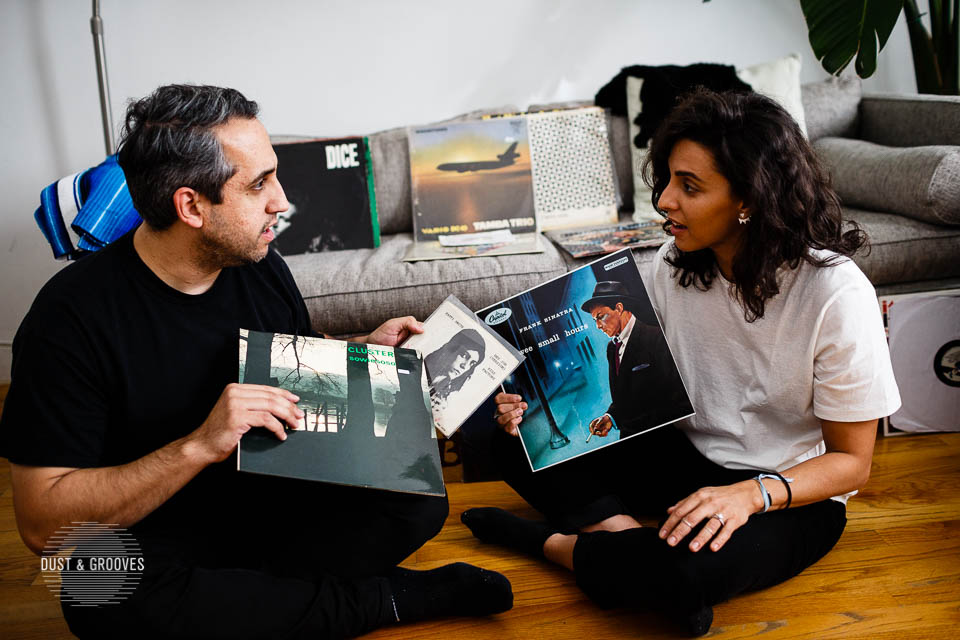 Cluster – Sowiesoso, Patti Smith – “Piss Factory,” and Frank Sinatra – In The Wee Small Hours. Three records that represent our interpretation of “the three bardos”— David Mancuso’s philosophy on the phases of a musical journey throughout an evening. Calm: when people are arriving and warming up; Circus: a high energy state; and Re-entry: helping people ease back into the outside world or “landing the plane.”
Cluster – Sowiesoso, Patti Smith – “Piss Factory,” and Frank Sinatra – In The Wee Small Hours. Three records that represent our interpretation of “the three bardos”— David Mancuso’s philosophy on the phases of a musical journey throughout an evening. Calm: when people are arriving and warming up; Circus: a high energy state; and Re-entry: helping people ease back into the outside world or “landing the plane.”
What are some records you played at the last party that stand out in your mind?
Barbie: We do a lot of combing through records in preparation for them, but that’s not to say that we have a plan for the night. There’s always that one record that you want to play and it just never works out. So, I try to work it into the next one.
I’m a huge Patti Smith fan. I love my “Piss Factory” 7-inch, with her xeroxed photo and blurry autograph. I think the lyrics resonate so much with the version of me that lived in Miami and wanted to come to New York City to find herself and be part of something larger than what’s expected from society, like kids and a mortgage. It was one of the biggest moments at our last party.
 Patti Smith, “Piss Factory.” Her first single, and the highlight from our last Universal Love party.
Patti Smith, “Piss Factory.” Her first single, and the highlight from our last Universal Love party.
Also, I absolutely adore the drama of Harry Thurman’s “Underwater” and how that record really opens up the sound system. It’s always amazing to see the reaction in people’s bodies and faces because it’s such a journey.
Paul: The filter we put on anything we’re considering playing at Universal Love is that it needs to be a “song.” It needs to have a beginning, a middle and an end. The opposite of that would be a “track” that’s made on a step sequencer with changes, variations and modulations, but are usually linear in nature. We look for songs in all genres and time periods, and that’s what keeps those parties different from other parties we do. We also are thinking about and pushing David [Mancuso’s] idea of the three phases of a night: Calm, Circus and Re-entry. Calm is when folks are just arriving, getting settled and finding their place on the floor; Circus is where the full-on party moments and hardest dancing occurs, and finally, Re-entry is where we “land the plane.” A plane can’t just drop out of the sky, it needs to land gracefully so people can walk out into the normal world again in one piece. We think about this a lot and try to push it. We’ve noticed that it might be wise to consider two extra phases between calm and circus, and between circus and re-entry. For us, it helps to think about these two extra phases as they are crucial to executing the subtle shifts of energy that bring us into the next major part of the party. Cluster’s “Sowiesoso” is a perfect example of something we’ve played early in the night but that has a swaying undercurrent which makes it good to dance to. We found it in an amazing little record store in Fukuoka, Japan.
Paul, as someone with a graphic design background, all the work you produce and its related ephemera incorporate a significant design element. What role do you feel that design plays in the underground music community, or culture in general, and what are some of your favorite records, design-wise?
Paul: It’s hard to say if it plays a significant role in the underground music community now. I hardly hear people talking about cover art as it relates to new music. Danny Krivit says that back in the day, a great cover usually meant that the music was going to be good, but these days that theory is totally false. It’s a real toss-up.
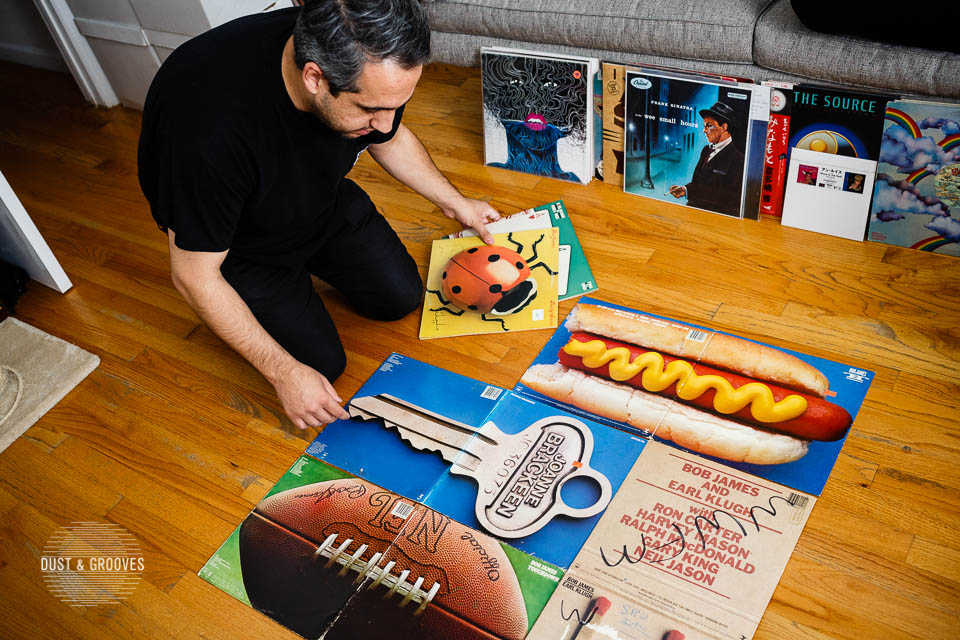 Collection of Bob James record covers designed by one of my favorite designers and probably the most accomplished single designer living today – Paula Scher, who was then the art director for CBS and Bob’s Tappan Zee records.
Collection of Bob James record covers designed by one of my favorite designers and probably the most accomplished single designer living today – Paula Scher, who was then the art director for CBS and Bob’s Tappan Zee records.
As a graphic design history fan, I love finding covers that Paula Scher made. She was in-house for CBS in the 70s and did all of those Bob James records with the large objects on them. The key, the hot dog, matchbook, etc. She said the bigger stars always wanted their faces on the covers, but the jazz guys didn’t care and let her dictate the direction, so she had room to experiment. There’s a great mini-doc on her on Netflix now as part of the series Abstract that I recommend. She also did the identity for the Public Theater, Citibank and tons of other things you see every day. Much to her chagrin, most people know her for the cover she did for Boston. The one with the flying guitars.
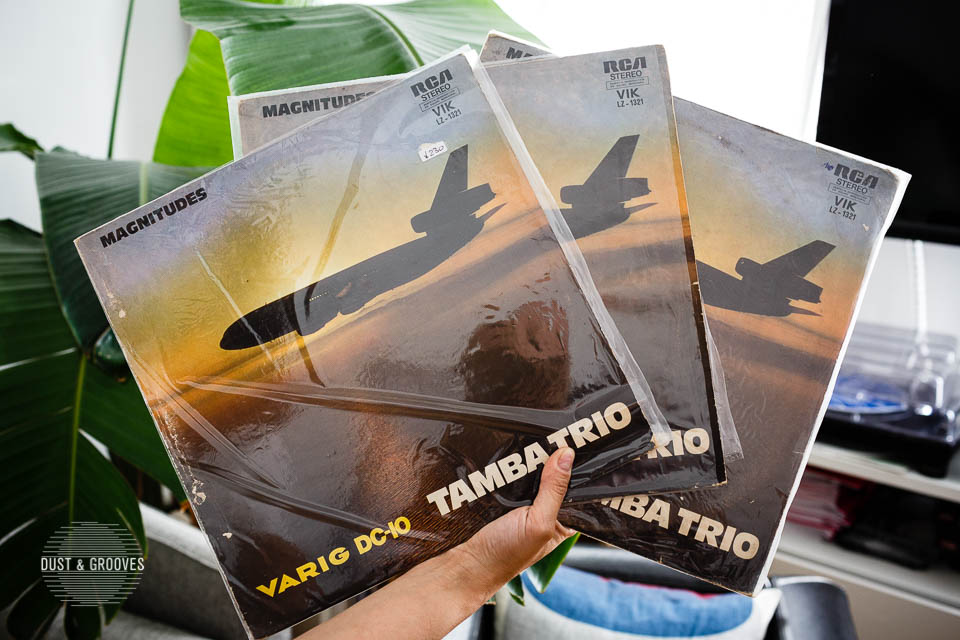 Tamba Trio, Magnitudes. Earlier in 2018, we kept running into this record in Buenos Aires and each time it looked fresh in our eyes. We unknowingly ended up with three copies.
Tamba Trio, Magnitudes. Earlier in 2018, we kept running into this record in Buenos Aires and each time it looked fresh in our eyes. We unknowingly ended up with three copies. 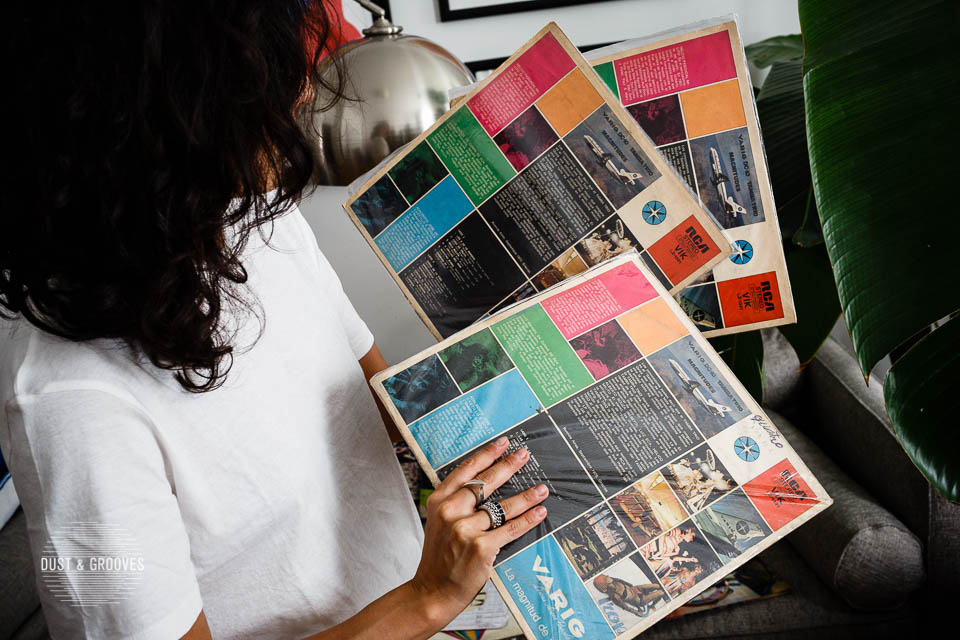 The art is striking. Varig was the first airline founded in Brazil. This also has to be where the famous Ibiza club DC-10 gets its name.
The art is striking. Varig was the first airline founded in Brazil. This also has to be where the famous Ibiza club DC-10 gets its name.
You guys recently went on tour in Japan, and I know you did a lot of digging. What are some pieces you found there that you are really excited about?
Barbie: There’s so much about Japan that we fell in love with. It wasn’t just about the digging. What we were really taken by is the care and attention to detail across the board, but especially within record stores. There was an Argentine record section at Recofan! That’s totally unheard of. Yet there I was, on the other side of the world, and my home country had its little section with folklore, tango, and more. It killed me.
But if we must discuss the digging… J-Pop stuff from the ‘80s is what gets the most buzz in the world of record nerds and sure, there’s plenty. I’m particularly in love with this 45 that HMV just reissued called “Alone in the Dark.” It’s sonically wonderful and a beautiful pop song.
Speaking of sonically wonderful, we had life-changing experiences at various Kissaten—tea rooms where they play music over hi-fi, usually of quality, and there’s mostly no talking allowed—I won’t name the ones we stumbled into because I’d rather have the discovery be part of your journey.
The hospitality there is unparalleled and we were lucky enough to be hosted by the most wonderful people. Masuo from Desiderata in Fukuoka took us to this shop, the name escapes me, but it was something out of a dream. Taro from Synthesize and Max Essa in Tokyo were just the best. The highlight of the trip was flying to Sapporo for like eighteen hours just so we could hear Danny Krivit play at Precious Hall. Leaving to come back home, we immediately felt we had unfinished business, like we barely scratched the surface…so we’re planning to go back in 2019.
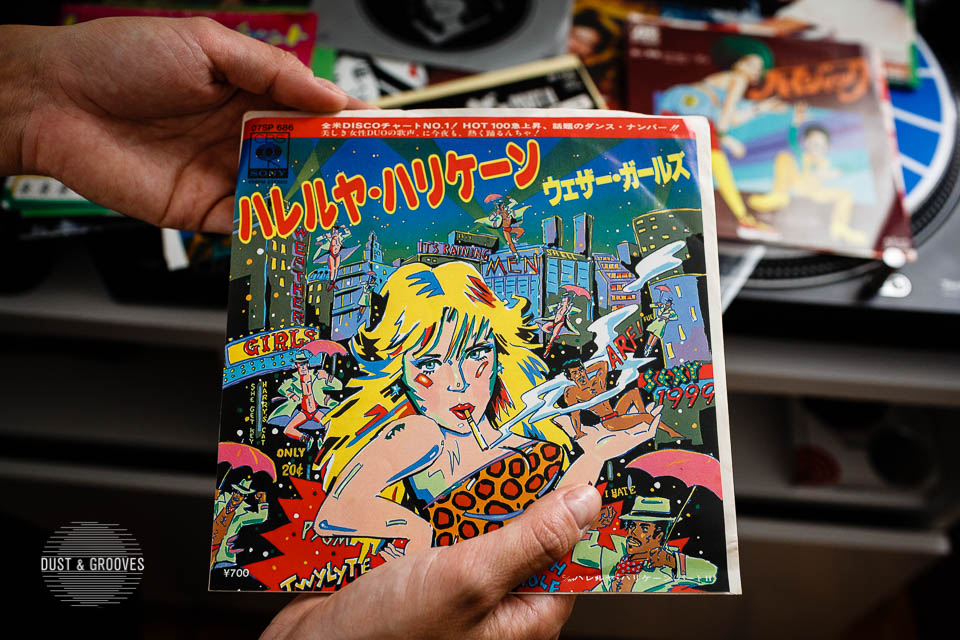
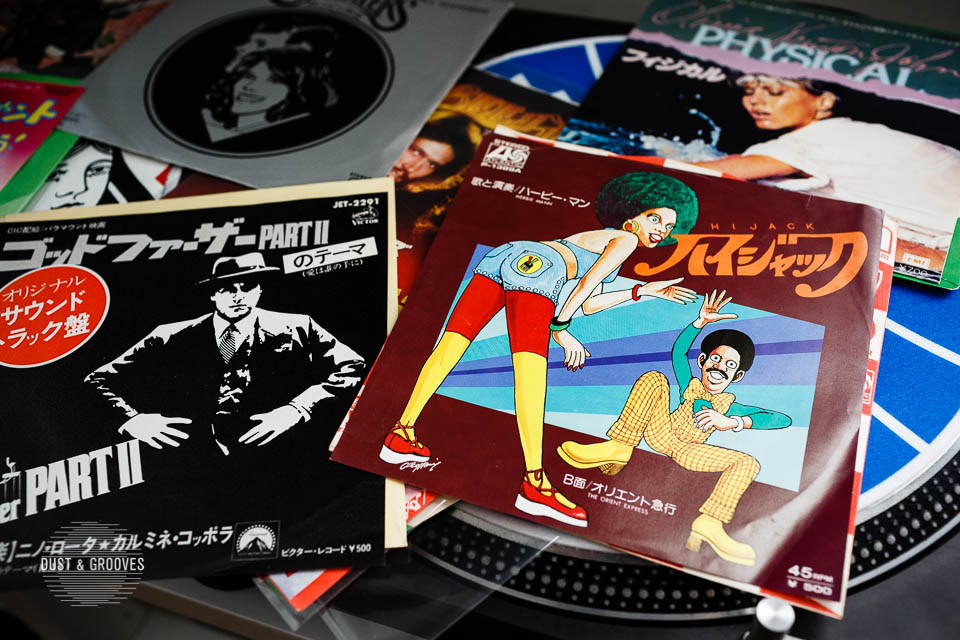
 These Japanese picture covers are incredible — although the titles are obvious, they were tough to pass up.
These Japanese picture covers are incredible — although the titles are obvious, they were tough to pass up.
Paul: Being in Japan with Danny Krivit was amazing in and of itself. I came across this pristine copy of Billy Paul’s Going East and Danny mentioned that it was a fantastic sounding record on Klipschorns. Being devoted fans of the loudspeaker, and knowing how honest they are, we’re after a certain sonic quality that’s not widely available. If you know these speakers, you’ll know that you cannot play everything on them. They are unforgiving: you play a bad pressing or a badly mixed or poor quality source, and you’ll immediately hear something is wrong. So I gave the record a listen and loved it. East became one of the staples at our parties because it truly captures the spirit of what we’re setting out to do: this spiritual, hazy, soulful piece that takes you on a trip–and it sounds incredible.
 Billy Paul, Going East. Sounds really nice on Klipschorns.
Billy Paul, Going East. Sounds really nice on Klipschorns.
And last but not least, the mandatory questions, who would u like to see on Dust & Grooves next?
Barbie: I’d give anything to check out all of Takaya Nagase’s record collection. He is a revered New York based selector and introduced me to Japanese sensibilities in sound and music. He’s got all these amazing records so humbly thrown around but they’re all gold, and, chances are, you’ve never heard of half the stuff he’s got there.
Also, Yuki from A-1 Records! She’s got absolutely killer taste. I love her selections. She was playing in her basement one night and it was just one after another…great music, played with a really nice intention.
Paul: Danny Krivit, Francois K, Elbin Reyes, Justin Strauss, Douglas Sherman.
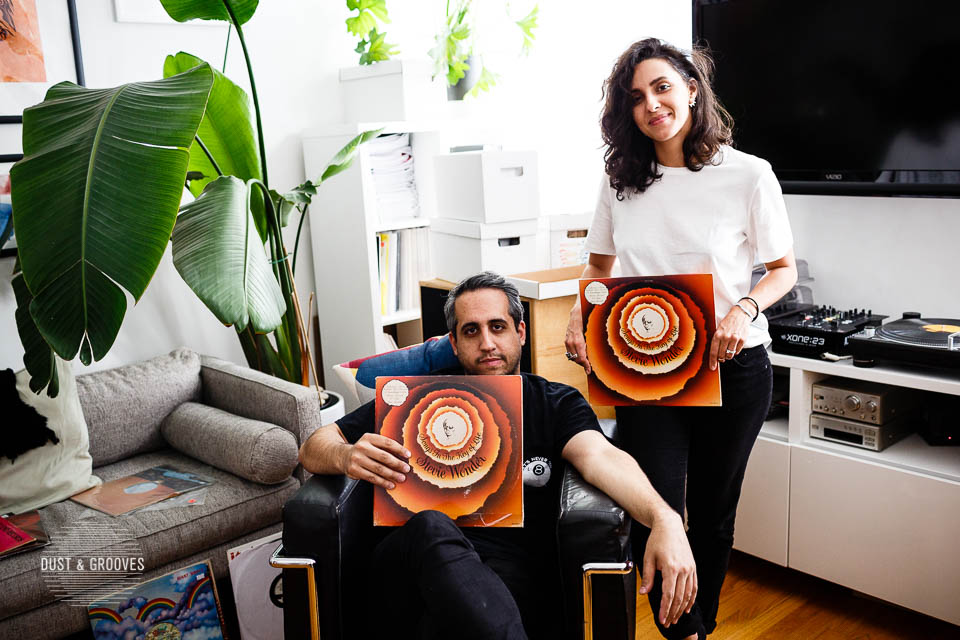
* Thanks to Sam Swig for helping out with research.
Please consider purchasing the Dust & Grooves book and continue your support of the Dust & Grooves project.

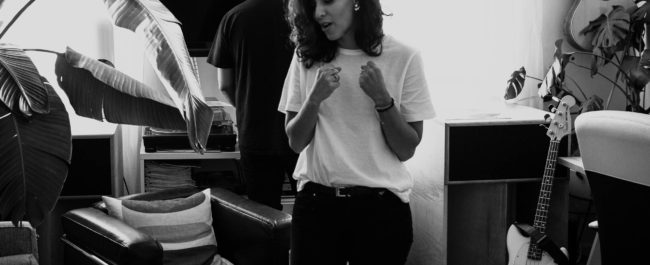

Excellent piece. I feel like I made new friends just by reading! I used to run a small distribution company in the mid-90s and DJ’ed a lot as well – really miss that time only life, and the music!
*in my life*
Nice article.Just one inaccuracy, the Juarez Santana Muito Legal lp is not ‘pre-Bossa’ it was released on the Brazilian Equipe label in 1965.